Well, it’s all downhill from here.
At least, that’s what I keep telling myself.
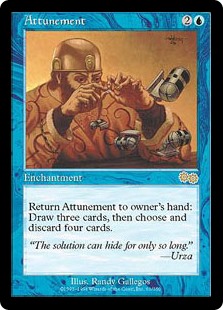
Deck construction in a nutshell
For those who take a more decisive and organic approach to making a Magic deck, by this point you’d have played multiple games already and were working on making substitutions. Through an empirical and interactive approach – again, one I feel is perfectly valid – at six weeks since inception you’d be using your first hand experiences to improve the aspects of the deck that didn’t work as smoothly or acutely as you wanted. Fine tuning via playtesting is completely fine.
Yet it’s not my style when it comes to EDH decks. If I was able to play Commander games more frequently, I’d be far more willing to attempt this style of approach more often, as it has great potential for quickly ascertaining if your choices panned out. Alas, as I remarked previously, that isn’t an quite as simple an option for many people with limited time to play.
As such, in addition to the criteria laid out at the onset (such as no looking at other decks), this is why our collaborative Alesha, Who Smiles At Death deck hasn’t been completed yet. For those such as myself who prefer to be more methodical and / or get as much ‘right’ about their deck as possible before it graces the kitchen table, we have yet to reach this stage.
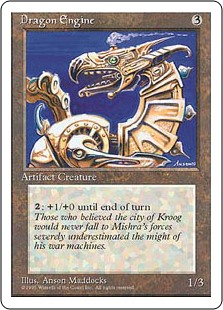
Feed The Engine! Engine hungry! Rawr!
We are, however, inching closer. We’re at that happy period of deck construction where you simply can’t believe it’s not done yet, although you’re fairly sure that faint light off in the distance is the tunnel exit.
Indeed, the single biggest problem with taking the long-form approach to deck building is risking the very real fear of running out of steam. Patience and perseverance are necessary to solve the fundamental issue of interest flickering out.
Think about it: how many other times have you started dabbling in a new skill or hobby, with interest at peak levels, only to lose it shortly thereafter? We’ve all done this at some point. Now imagine having to take an eight week training class before getting to that point. You want to learn how to knit? Fantastic! But first, read this tome on the history of textiles.
Therefore, in an effort to alleviate the doldrums period of deck construction and keep us moving along, this week we’re going to just dive right in.
Part Six: The Utility Belt
When we last left off, we had just done our first wave of minor deck edits. After several weeks of compiling creatures, artifacts, and enchantments, it was deemed prudent to see about cycling some cards that had gotten overlooked the first time around. While this didn’t help us shrink our pool of cards any, it was beneficial nevertheless for shaping our priorities.
By looking at the complete list of permanents to consider (not including mana fixing), we were then able to see where the deck was well covered and where it could use some shoring up. Looking at those areas, we were finally able to turn our attention towards spells.
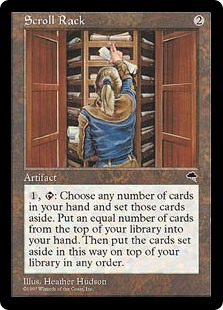
Pretty much how I feel whenever choosing spells
As a old-timey Magic player, I have a fondness for having lots of spells at the ready. I’ve come to accept that modern Magic cares at least as much about creatures (and arguably more) than it does spells, but like many who started in the early days, it’s an old habit to break. So when I went about throwing the pile of spells together, it felt like going on a shopping spree. My rough list for the spells portion of this deck ended up being roughly 60 cards. . .per color. While this sort of underscores Wizard’s point that useful spells absolutely still exist, I also knew that some serious cutbacks would have to be made right at the onset.
I just got a little carried away is all.
It’s allowed!
Much like how we approached the other sections, a large pool to consider isn’t a bad thing, but it can be tricky if you have an affinity for that card type. I don’t have the same adoration for creatures that many newer players do, for instance. I like them, and they’re necessary in most cases, but I rarely build super creature-heavy decks. Of course, that’s also the reason I went with challenging myself with Alesha. Because of this, though, space for spells will be limited.
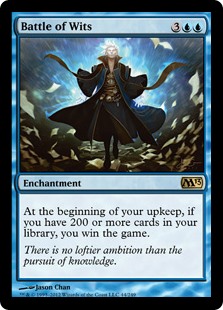
If only Double Commander was a thing
Similarly to the approach I took for the creature list, I took up the rather insane task of skimming through another couple thousand cards. I wasn’t nearly as thorough as before, however, as I was sure only a small percentage of any cards picked would end up making the final cut anyhow. Moreover, unlike creatures, I usually have a better grasp of the types of cards I’m looking for. So even though I probably glanced through 2,000 card or so, I had a much more focused mindset. Hence the ‘mere’ 170 or so rough list.
In cases of decks that aren’t spell-focused, my primary objective is always to use spells to plug areas of the deck where I feel there are gaps.
My secondary objective is more personally tailored: I am an unabashed fan of utility spells. It may seem like a broken record at this point, but one of the great things about Magic really is the freedom to tailor a deck to your personal play style. In an ideal setting, I want to be a spell-slinging Batman. It’s hardly an efficient tactic outside of multiplayer games – reason 812 why I prefer them to duels – but I love my deck having myriad answers to situations that come up.
Commander games brim with odd settings, and I personally love having cards that are gaming-saving in one setting while still usable in another. Your own search criteria for spell options will vary, but having some sort of identifiable purpose when browsing at this stage of EDH creation helps avoid burnout. Utility spells work for me, but your mileage may vary.
After having the 170 or so raw card readout, I whittled through them fairly quickly. Many painful choices were made, cutting cards that I even initially had thought were automatic deck inclusions before beginning my search such as Cauldron Haze and Rescue From The Underworld. Surprisingly, they didn’t make the semi-finals. These did:
Alesha's Utility Belt
| Board Wipes (4) 1 Arcbond 1 Austere Command 1 Retribution of the Meek 1 Tragic Arrogance Combat Manipulation (6) 1 Aurelia’s Fury 1 Master Warcraft 1 Mob Rule 1 Order / Chaos 1 Savage Beating 1 Waves of Aggression Card Draw And Tutoring (4) 1 Beseech the Queen 1 Demonic Collusion 1 Gleam of Resistance 1 Toil / Trouble Creature Spot Removal (5) 1 Agonizing Demise 1 Crackling Doom 1 Crib Swap 1 Utter End 1 Valorous Stance Artifact / Enchantment Spot Removal (5) 1 Hide / Seek 1 Kolaghan’s Command 1 Mortify 1 Oblation 1 Orim’s Thunder Damage Prevention Effects (7) 1 Awe Strike 1 Boros Fury-Shield 1 Comeuppance 1 Dawn Charm 1 Deflecting Palm 1 Delirium 1 Reflect Damage Creature Resurrection (4) 1 Faith’s Reward 1 Grim Return 1 Obzedat’s Aid 1 Unburial Rites Graveyard Manipulation (5) 1 Buried Alive 1 Delirium Skeins 1 Entomb 1 Incendiary Command 1 Insidious Dreams Other (6) 1 Boros Charm 1 From the Ashes 1 Praetor’s Grasp 1 Otherworldly Journey 1 Rakdos Charm 1 Wild Ricochet |
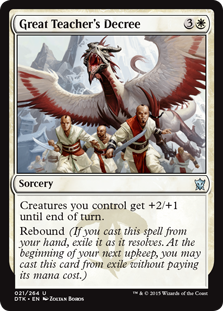
I demand you have All The Staples!
Now, some people will advocate (or even insist) that when you compile a subset of cards – particularly spells – that you have to organize them by specific set categories, similar to those shown above. I admit that this can be a very help approach when it comes to organizing your card choices.
However, much like I don’t subscribe to the idea of EDH staples, I don’t believe that you have to fulfill certain check boxes every time you make a deck. Unless they are cards specifically tailored to the deck or Commander’s central premise, I tend to make organization boxes after the fact as a means of cutting cards down, rather than adhering to specific auto-include lists. So certainly use them in whichever manner works best for you, but don’t feel like you have to be beholden to them.
Plus, it can also be difficult organizing multi-use cards. Personally, when I have cards that can fit into more than one of those columns, such as Utter End, I select the primary reason I want them in the deck. Insidious Dreams is in the Graveyard Manipulation pile even though it’s a tutor, for example, because the main reason I wanted it is the idea of being able to discard creatures for Alesha. Getting to tutor in the process is more of the 1A effect.
After organizing the spell list, several familiar categories emerged. Some of these were deliberate, including board wipes, fog effects, and spot removal. Others include my aforementioned admiration for utility cards.
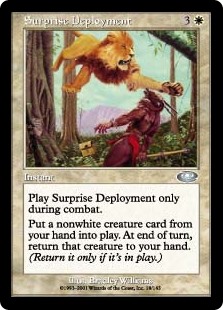
Betcha didn’t see that coming!
Finally, there were the surprises. Part of the great fun with a methodical approach that you fail to get using a more direct deck building approach is that you often find unexpected things as you sift through cards. There are plenty of times when you start off with one idea and ultimately settle on another you hadn’t even considered – a direct result of your investigative work.
To that end, there was indeed pattern of card choices that emerged which was fantastic and unexpected. This specific pile of cards wasn’t one I’d considered at first, but the more I toyed with the idea, the more I found it thematically fitting with Alesha’s bravado. These are backlash card: defensive in nature but punish the opponent at the same time.
Many of them fall into the damage prevention camp (Boros Fury-Shield, Comeuppance, Deflecting Palm, Reflect Damage, etc.) but stuff like Agonizing Demise, Arcbond, and Rakdos Charm fit as well. There were even more of these prior to the drop to 40ish cards, but it was apparent early on that I found this style of card incredibly fitting with Alesha and ran with it ever since. Don’t be dismissive of unexpected turns your deck may take when playing the long con. Your deck may be all the better for it. We’ll see how many make the final cut, but I’m going to try to keep as many as I can at the moment. Unless I change my mind again.
And now we have it. Short of mana fixing and land, we have traversed every category for Alesha and plucked out what I felt fit both my Commander and my own personal preferences.
Alesha's Season Two Semi Finalists
As the list shows, however, we are far from being finished. At 166 cards, this is more than twice the number of cards needed. Around 100 cards still need to be cut to make the deck viable, which means it’s time for some tough love. Next week, we see the result of making hard choices and hard cuts. What should stay? What should go? Only time – and your input – will tell. Till then!
